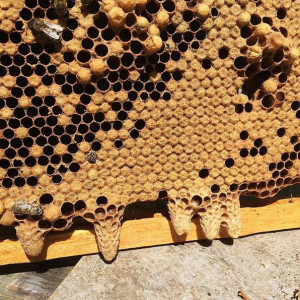My Hive Has Queen Cells And A Laying Queen! Now What?
By: Blake Shook
Unfortunately, it's not uncommon to see an active queen and queen cells. But before we talk about what to do about it, let us first break down the different types of queen cells found in a hive. To start, a queen cell is simply a cell in which a queen is actively being raised. A queen cup, or emergency queen cup as they are often called, is an empty queen cup that bees often have in the hive. Bees keep these empty cups ready in case they need to rear a queen. But, unless it has a larva in it, it’s of no concern. If there is a developing larva in the cell, then you need to decide if it is:
- A supersedure cell - the bees replacing a failing queen.
- A swarm cell - half of the bees are preparing to leave with the queen.
- An emergency queen - the hive has lost their previous queen.

If you read most beekeeping books, they explain that supersedure cells (queens being raised to replace a failing queen) and swarm cells (queens being raised in preparation for half the bees & the old queen to swarm away) are easy to spot. Swarm cells are typically located along the bottom & sides of frames, and supersedure cells are located in the middle of frames. Although that principle is often true, I’ve seen it fail many times as well. While keeping it in mind, here are a few additional ways to tell the difference: Supersedure cells:
- Often located in the middle of frames
- Typically found in weakening or dwindling hives that aren’t full of bees
- Found all times of the year
- Hive often appears weak, with a poor brood pattern
- Often only a few queen cells Swarm cells:

- Often located along the bottom & sides of a frame
- Found in overcrowded hives, where every box is more than 80% full of bees
- 90% of the time found in Spring or very early Summer
- Hive appears generally healthy, full of bees & brood, with a good brood pattern
- Often 5-20 cells

In a nutshell, swarm cells are found in healthy, overcrowded hives preparing to swarm. Supersedure cells are usually in weakening hives which need a new queen, so the bees are preparing to requeen themselves.
If you are seeing queen cells and have a laying queen in your hive (verified by seeing her), or you are seeing plenty of healthy eggs, larva and brood, there are a few things you need to do.

- Make sure what you are seeing are actually queen cells.
- Make sure you don’t have a drone layer laying eggs rather than a queen.
 Queenless - Laying worker hive (Drone Layer)
Queenless - Laying worker hive (Drone Layer)
If neither of the above are relevant, then typically 1 of 2 things are happening.
- If your hive has a newly introduced (last 1-2 weeks) queen, bees can still raise queen cells as the new queen’s pheromones fully develop. If that is the case, simply wipe out the developing queen cells.
- If the queen is not new, chances are they are raising supersedure cells to replace a failing queen. In this case it is best to order a new queen quickly, wipe out the queen cells, remove the old queen when the new one arrives, and install a new queen in the hive
NOTE: It only takes the bees 12 days to raise a new queen when they start with a 24-hour old larva, so you don’t have a lot of time to replace the queen. If you already see capped queen cells, gently uncap one of them. If there is a fully developed white pupa in the cell, you will need a new queen within 2-3 days, otherwise it will be too late, and the new queens will begin hatching out by the time you get a new queen. If the pupa is already turning brown, it’s too late...they usually hatch within 1-2 days. Chances are if you try to wipe out all the queen cells, you will most likely miss one, and that virgin queen will kill the queen you introduce.

